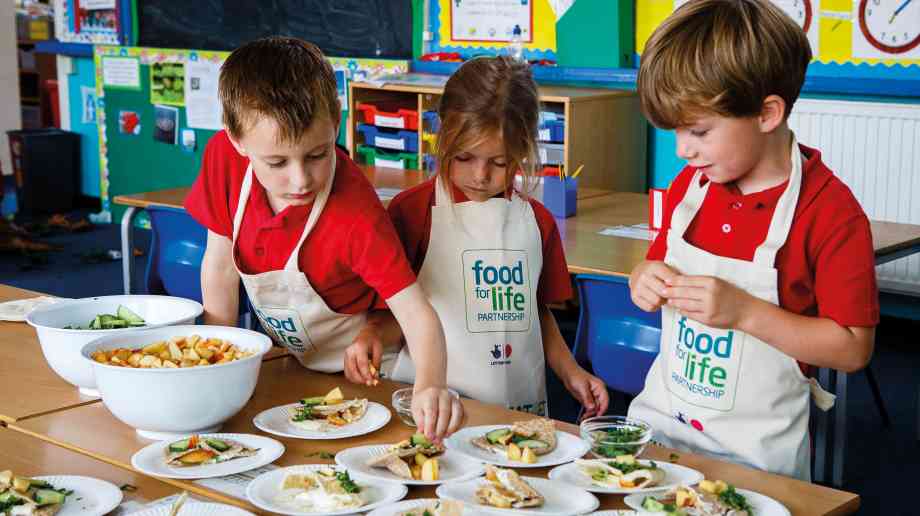
Reaping the benefits of a whole school approach to food
With new frameworks in place to monitor how schools support health eating, Jo Wild of Food For Life examines the benefits that healthy school meals can have on pupil well-being and attainment, and why schools should be more engaged in cooking and learning about where food comes from.
School food has come a long way since it was thrust into the spotlight by Jamie Oliver and his battle against the infamous turkey twizzler a little over ten years ago. There has been a clear, measurable improvement in the quality of school food which has been further accelerated in the last two years by the implementation of actions recommended by the independent School Food Plan.
The Plan aimed to ensure that not only did school food guarantee that pupils were well-fuelled to learn, but that it also plays a positive role in their overall health and wellbeing. Key initiatives that began with the School Food Plan, including universal free school meals for infants, the reintroduction of cooking in the curriculum and an updated set of School Food Standards, have all been implemented with children’s health in mind.
The role that food and food education at school plays in children’s health has been further highlighted by the new Ofsted Common Inspection Framework which requires inspectors to look at how schools are supporting ‘children and learners keep themselves healthy, including through healthy eating’. In an update at the start of the year, inspectors were asked to familiarise themselves with the School Food Plan’s guidance around developing a whole school approach to food as it is ‘relevant to their assessment of how schools are supporting pupils to keep themselves healthy’.
But in practice, can this be easily evidenced by schools and headteachers who already have many demands on their time and resources? And can healthy eating and food education be woven into school life and support not just pupils’ health, but their learning and the wider curriculum?
The team behind the Soil Association’s Food for Life school award believe that it can. The award has already been cited in the School Food Plan guidance as one of the ways that schools can evidence how they are supporting pupils to be healthy. Sian Creagh-Osborne, Awards Manager for the programme, tells us more: “The key to success in Food for Life schools is a simple one; a whole school approach which brings together all those who are involved in school food, including pupils, caterers, staff and parents. “It’s not a ‘one size fits all’ approach, but a framework that supports schools to look at the quality of the food they are serving, how they can create an environment that makes lunchtime an enjoyable experience and provide food-based education, including practical cooking, growing and visits to farms.
“We see schools approaching the programme in ways that suit them and that fit with their wider priorities. Our job is to provide the resources and guidance that allows them to do this and create a positive culture that not only supports pupils’ health now, but provides them with the skills and knowledge that will help them to make good, healthy food choices in the future.”
An evidence-based approach
Independent evaluation of the programme indicates that the programme is achieving what it sets out to do. Researchers from the University of the West of England found that pupils in Food for Life schools were twice as likely to eat five or more portions of fruit and vegetables per day than those in other schools and significantly more fruit and vegetables at home.
Further research has also shown that the potential benefits of the programme go wider than pupil health, with FFL schools ‘consistently reporting that FFL had contributed to their school improvement agendas, helping improve attainment, behaviour and school environments’ and that the experiential learning resulting from Food for Life activity ‘appears to have been particularly effective at helping engage or re-engage pupils with learning issues and challenges.’
Sian continues: “Our work is about more than just the food on the plate; we support children, their carers and the wider community to understand the importance of good nutrition and where their food comes from. Where a school works with an external caterer, food quality is verified through the Food for Life Catering Mark, which allows schools to demonstrate that the food they serve is nutritious, locally sourced and meets the school food standards.
“The emphasis of the Food for Life award is on learning through experience and enjoying that learning! Schools grow their own food, visit local farms, source food from local producers and set up schools farmers markets. They set up cooking and growing clubs for pupils and their families and make lunchtime an attractive feature of the school day.”
A good food culture
Food for Life Silver award holders Clifton Green School in York took some time out to tell us how they are ensuring healthy eating and food education isn’t just a time-consuming addition, but something which enriches school life for their pupils and wider community.
Even the briefest of visits gives you a sense that good food is embedded across the school and curriculum, from the displays in the corridors to the well planted garden and photos on the school’s website.
Lisa Green is Food Development Manager for the school and leads on their Food for Life work. She tells us they are feeling confident that they already have good systems in place which demonstrate they are supporting pupils to be healthy. She said: “We pride ourselves on using food as a vehicle for learning across growing, cooking, outdoor learning and beyond so our pupils are immersed in a good food culture. I think many schools are wondering what evidence they need to show and how to record what they do.
“What they may be missing is a way of concisely documenting it and rather than start from scratch, they should look at the Food for Life School awards – I think they would be pleasantly surprised about how much they already do. If you cook with your pupils, involve parents in school meals and have displays for inspectors to see about food education you are well on the way.”
But even a school like Clifton Green isn’t resting on its laurels. New initiatives include the school chef involving a panel of pupils in menu creation, ensuring the views of the customer are taken into account. As well as supporting good meal take up, they believe working on menus that also meet nutritional guidelines teaches pupils a valuable lesson about how to eat well.
A Network of Inspirational Schools
Clifton Green School is one of many inspirational Food for Life schools, many of whom have exceeded their own expectations in terms of what they have achieved thanks to the flexibility of the award framework. Putting pupils and the wider school community at the heart of a school food policy can lead to creative solutions to issues which previously may have been barriers to success.
Food for Life’s Sian concludes: “Ofsted may be the driver for some school leaders to record their work around healthy eating, but Food for Life schools demonstrate that a whole school approach to food can have much wider benefits to both learning and pupil well-being.”
Further information
www.foodforlife.org.uk/schools
Latest News
21/11/2025 - 09:37
The framework provides a practical guide to integrating education and health for better outcomes for children and young people.
20/11/2025 - 10:42
Parents will be able to get Enhanced Disclosure and Barring Service (DBS) checks when hiring private tutors, carers and therapists, among others.
20/11/2025 - 10:37
The government is funding research into developing smarter data tools to help identify children with special educational needs sooner.
20/11/2025 - 09:48
The programme prioritises schools with the highest proportion of pupils on free school meals to ensure the benefits are felt where it is most needed.
19/11/2025 - 09:41
Skills England has announced that development of the second round of Local Skills Improvement Plans (LSIPs) is now underway and has published guidance to steer the process







